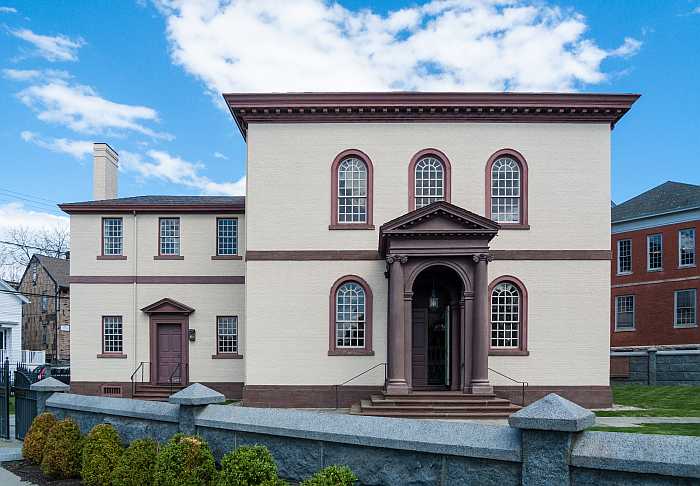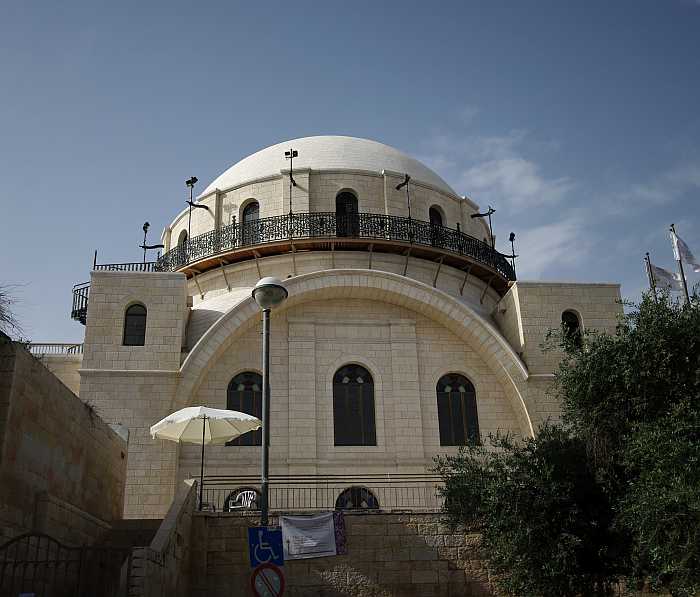
Dohany Street Synagogue in Budapest (Photo: Acediscovery, CC BY 4.0, via Wikimedia Commons)
Synagogues, also known as shuls, are much more than places for prayer. They are sanctuaries—spaces where communities gather, celebrate, and find comfort. Across the world, these sacred sites hold stories of resilience, faith, and tradition. Each one reflects the history and character of the Jewish communities that built them.
In this blog, we’re taking you on a journey to 14 synagogues you simply must visit in your lifetime. From medieval structures in Europe to modern-day wonders, each synagogue on this list has something special to share. Whether it’s their stunning design, rich history, or connection to legendary tales, these synagogues will leave you in awe. Let’s dive in and explore!
1. The Great Synagogue of Budapest (Dohány Street Synagogue) - Budapest, Hungary
Location: Dohány Street, Jewish Quarter, Budapest.
History: Constructed between 1854 and 1859, this synagogue reflects the grandeur of Moorish Revival architecture with Byzantine influences. It served as a focal point of Jewish life in Hungary and played a tragic role during the Holocaust as part of the Budapest Ghetto.
Why it’s special:
- Largest synagogue in Europe and a defining symbol of Hungarian Jewish heritage.
- Houses a Holocaust memorial park, a museum, and the Tree of Life memorial.
- Renowned for its ornate Moorish arches and intricately designed interiors.
2. Synagogue of El Transito - Toledo, Spain
Location: Toledo, near Madrid, Spain.
History: Built in 1357 by Samuel ha-Levi, the synagogue is a testament to Spain's thriving Jewish community during the medieval era. It endured the 1492 expulsion, later functioning as a church before becoming the Sephardic Museum.
Why it’s special:
- Exemplifies Mudéjar architecture, blending Gothic and Islamic styles.
- Features exquisite stucco work and Hebrew inscriptions from Spain's Jewish Golden Age.
- A window into Sephardic Jewish history through its museum exhibits.

Touro Synagogue in Newport, RI (Photo: Kenneth C. Zirkel, CC BY 4.0, via Wikimedia Commons)
3. Touro Synagogue - Newport, Rhode Island, USA
3. Touro Synagogue - Newport, Rhode Island, USA
Location: Newport, Rhode Island.
History: Established in 1763 by Sephardic immigrants, Touro Synagogue is the oldest in the United States. Its design reflects the aspirations of colonial America’s Jewish community.
Why it’s special:
- A landmark of early American religious freedom, cited in George Washington’s famous letter advocating tolerance.
- Unique architectural blend of Georgian and colonial styles.
- Integral to Jewish life during America’s early years.
4. Bevis Marks Synagogue - London, United Kingdom
Location: Bevis Marks, City of London.
History: Completed in 1701, this synagogue was built by Sephardic Jews escaping persecution in Spain and Portugal. It draws design inspiration from Amsterdam’s Great Synagogue and has remained in continuous use ever since.
Why it’s special:
- Oldest active synagogue in the UK, symbolizing resilience and religious freedom.
- Preserved with its original wooden benches, brass chandeliers, and understated elegance.
- A cornerstone of London’s Sephardic Jewish community for over three centuries.

Hurva Synagogue in Jerusalem (Photo: Emmanuel Dyan, CC BY 2.0, via Wikimedia Commons)
5. The Hurva Synagogue - Jerusalem, Israel
Location: Jewish Quarter, Old City, Jerusalem.
History: Originally built in 1701, destroyed, and rebuilt multiple times, the Hurva Synagogue’s most recent restoration was completed in 2010. Its history reflects the perseverance of Jerusalem’s Jewish community.
Why it’s special:
- Iconic white dome dominating the Old City’s skyline.
- A vivid reminder of Jerusalem’s turbulent history, combining resilience with renewal.
- Functions as both a synagogue and a key historical attraction.

Museum at Eldridge Street Synagogue in NYC (Photo: Al Patsiko, CC BY-SA 4.0, via Wikimedia Commons)
6. Eldridge Street Synagogue - New York City, USA
6. Eldridge Street Synagogue - New York City, USA
Location: Manhattan’s Lower East Side, New York City.
History: Opened in 1887, this synagogue was among the first built by Eastern European Jewish immigrants in the U.S. As the Jewish population moved to other neighborhoods in the mid-20th century, the synagogue fell into disrepair. It was later restored and reopened in 2007 as the Museum at Eldridge Street, preserving the building’s history and architecture.
Why it’s special:
- A beautifully restored example of Romanesque and Moorish Revival architecture.
- Features vibrant stained-glass windows and intricately carved wooden details.
- While primarily a museum, the congregation still holds services in alternate spaces, maintaining its legacy as a house of worship.
7. The Old-New Synagogue (Altneuschul) - Prague, Czech Republic
Location: Josefov, Prague’s Jewish Quarter.
History: Built in 1270, this synagogue has served Prague’s Jewish community for over 750 years. It is famously associated with Rabbi Judah Loew and the Golem legend.
Why it’s special:
- Oldest functioning synagogue in Europe, showcasing Gothic architecture.
- Houses original 13th-century artifacts, including benches and Torah scrolls.
- Steeped in mysticism and folklore, making it a cultural treasure.

Synagogue of Florence (Photo: Yair Haklai, CC BY-SA 4.0, via Wikimedia Commons)
8. Synagogue of Florence (Tempio Maggiore Israelitico) - Florence, Italy
Location: Florence, Italy.
History: Built between 1874 and 1882, it became a symbol of Jewish integration into Florentine society post-emancipation. Damaged during WWII, it was later restored.
Why it’s special:
- Known for its green dome and fusion of Moorish, Byzantine, and Italian designs.
- Houses the Jewish Museum of Florence, highlighting the contributions of local Jews.
- A remarkable survivor of war and prejudice.
9. Paradesi Synagogue - Kochi, India
Location: Mattancherry, Kochi, Kerala.
History: Built in 1568, it became a center of Jewish life along the Indian Ocean trade route, serving Sephardic merchants who settled in India.
Why it’s special:
- Oldest active synagogue in the Commonwealth of Nations.
- Decorated with hand-painted Chinese tiles and Belgian glass chandeliers.
- A testament to centuries of harmonious Jewish presence in India.

Abuhav Synagogue in Safed (Photo: israeltourism, CC BY-SA 2.0, via Wikimedia Commons)
10. Abuhav Synagogue - Safed, Israel
Location: Safed, Northern Israel.
History: Founded in the 16th century by exiled Spanish Jews, it is named after Rabbi Isaac Abuhav, a prominent scholar.
Why it’s special:
- Showcases Safed’s role as the center of Jewish mysticism.
- Decorated with Kabbalistic motifs and a sacred Torah scroll.
- A deeply spiritual site attracting visitors for its history and serenity.
11. The Great Synagogue of Rome (Tempio Maggiore di Roma) - Rome, Italy
Location: Jewish Ghetto, near the Tiber River, Rome.
History: Completed in 1904, it marks a new era for Jews in Italy after centuries of restrictions in the ghetto.
Why it’s special:
- Distinguished by its square dome and blend of Assyrian, Babylonian, and Roman designs.
- Includes a museum detailing 2,000 years of Jewish history in Rome.
- A spiritual and cultural center for one of Europe’s oldest Jewish communities.

Heichal Yehuda in Tel Aviv (Photo: Leon Yaakov, CC BY 2.0, via Wikimedia Commons)
12. Hechal Yehuda Synagogue (The Recanati Synagogue) - Tel Aviv, Israel
Location: Central Tel Aviv, on Ben Saruk Street.
History: Built in 1980, this synagogue is inspired by a seashell, symbolizing creativity and renewal in the Jewish state.
Why it’s special:
- Known as "The Seashell Synagogue" for its unique, modern architecture.
- Reflects Tel Aviv’s blend of tradition and innovation.
- Serves as an active house of worship and a cultural landmark.
13. Rykestrasse Synagogue - Berlin, Germany
Location: Prenzlauer Berg district, Berlin.

Location: Prenzlauer Berg district, Berlin.
History: Completed in 1904, it is the largest synagogue in Germany. Surviving Kristallnacht, it underwent extensive restoration before reopening in 2007.
Why it’s special:
- Represents the revival of Jewish life in post-Holocaust Germany.
- Adorned with stunning neo-Romanesque architecture and vibrant stained glass.
- A beacon of Berlin’s Jewish history and resilience.

Entrance to the Mikve Israel-Emanuel Synagogue (Photo: Curaçao Tourist Board)
14. Mikvé Israel-Emanuel Synagogue - Willemstad, Curaçao
Location: Punda district, Willemstad, Curaçao.
History: Built in 1732, it served Sephardic Jews fleeing the Iberian Peninsula and is the oldest active synagogue in the Americas.
Why it’s special:
- Famous for its sand-covered floors, symbolizing secret prayers during the Inquisition.
- Central to Curaçao’s Jewish history and a UNESCO World Heritage Site.
- Offers an immersive experience of Sephardic tradition in the Caribbean.
Conclusion
Visiting these 14 synagogues offers an incredible journey through Jewish history, architecture, and tradition. From the medieval alleys of Prague to the vibrant streets of Curaçao, each synagogue tells a unique story of resilience, faith, and community. Whether you’re drawn by their stunning designs, rich histories, or spiritual significance, these sacred spaces are truly unforgettable.
Search our kosher travel directory to find kosher restaurants and local minyanim, ensuring your journey is as seamless as it is inspiring. Wherever you go, these resources will help you immerse yourself in the rich history of Jewish life.